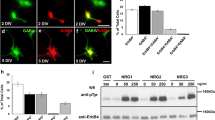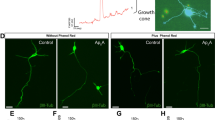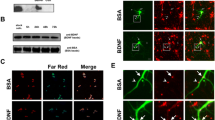Abstract
Axon growth and dendrite development are key processes for the establishment of a functional neuronal network. Adenosine, which is released by neurons and glia, is a known modulator of synaptic transmission but its influence over neuronal growth has been much less investigated. We now explored the action of adenosine A2A receptors (A2AR) upon neurite outgrowth, discriminating actions over the axon or dendrites, and the mechanisms involved. Morphometric analysis of primary cultures of cortical neurons from E18 Sprague–Dawley rats demonstrated that an A2AR agonist, CGS 21680, enhances axonal elongation and dendritic branching, being the former prevented by inhibitors of phosphoinositide 3-kinase, mitogen-activated protein kinase and phospholipase C, but not of protein kinase A. By testing the influence of a scavenger of BDNF (brain-derived neurotrophic factor) over the action of the A2AR agonist and the action of a selective A2AR antagonist over the action of BDNF, we could conclude that while the action of A2ARs upon dendritic branching is dependent on the presence of endogenous BDNF, the influence of A2ARs upon axonal elongation is independent of endogenous BDNF. In consonance with the action over axonal elongation, A2AR activation promoted a decrease in microtubule stability and an increase in microtubule growth speed in axonal growth cones. In conclusion, we disclose a facilitatory action of A2ARs upon axonal elongation and microtubule dynamics, providing new insights for A2ARs regulation of neuronal differentiation and axonal regeneration.











Similar content being viewed by others
References
Adén U, Herlenius E, Tang LQ, Fredholm BB (2000) Maternal caffeine intake has minor effects on adenosine receptor ontogeny in the rat brain. Pediatr Res 48:177–183. doi:10.1203/00006450-200008000-00010
Akhmanova A, Steinmetz MO (2008) Tracking the ends: a dynamic protein network controls the fate of microtubule tips. Nat Rev Mol Cell Biol 9:309–322. doi:10.1038/nrm2369
Assaife-Lopes N, Sousa VC, Pereira DB, Ribeiro JA, Sebastião AM (2014) Regulation of TrkB receptor translocation to lipid rafts by adenosine A2A receptors and its functional implications for BDNF-induced regulation of synaptic plasticity. Purinergic Signal 10:251–267. doi:10.1007/s11302-013-9383-2
Bartkowska K, Paquin A, Gauthier AS, Kaplan DR, Miller FD (2007) Trk signaling regulates neural precursor cell proliferation and differentiation during cortical development. Development 134:4369–4380. doi:10.1242/dev.008227
Bartrup JT, Moorman JM, Newberry NR (1997) BDNF enhances neuronal growth and synaptic activity in hippocampal cell cultures. NeuroReport 8:3791–3794
Bernhardt R, Matus A (1984) Light and electron microscopic studies of the distribution of microtubule-associated protein 2 in rat brain: a difference between dendritic and axonal cytoskeletons. J Comp Neurol 226:203–221. doi:10.1002/cne.902260205
Burbank KS, Mitchison TJ (2006) Microtubule dynamic instability. Curr Biol 16:R516–R517. doi:10.1016/j.cub.2006.06.044
Burkhalter J, Fiumelli H, Erickson JD, Martin JL (2007) A critical role for system A amino acid transport in the regulation of dendritic development by brain-derived neurotrophic factor (BDNF). J Biol Chem 282:5152–5159. doi:10.1074/jbc.M608548200
Caceres A, Banker G, Steward O, Binder L, Payne M (1984) MAP2 is localized to the dendrites of hippocampal neurons which develop in culture. Brain Res 315:314–318. doi:10.1016/0165-3806(84)90167-6
Caceres A, Banker GA, Binder L (1986) Immunocytochemical localization of tubulin and microtubule-associated protein 2 during the development of hippocampal neurons in culture. J Neurosci 6:714–722
Canals M, Angulo E, Casado V, Canela EI, Mallol J, Vinals F, Staines W, Tinner B, Hillion J, Agnati L, Fuxe K, Ferre S, Lluis C, Franco R (2005) Molecular mechanisms involved in the adenosine A and A receptor-induced neuronal differentiation in neuroblastoma cells and striatal primary cultures. J Neurochem 92:337–348. doi:10.1111/j.1471-4159.2004.02856.x
Charles MP, Adamski D, Kholler B, Pelletier L, Berger F, Wion D (2003) Induction of neurite outgrowth in PC12 cells by the bacterial nucleoside N6-methyldeoxyadenosine is mediated through adenosine A2a receptors and via cAMP and MAPK signaling pathways. Biochem Biophys Res Commun 304:795–800. doi:10.1016/S0006-291X(03)00666-1
Cheng HC, Shih HM, Chern Y (2002) Essential role of cAMP-response element-binding protein activation by A2A adenosine receptors in rescuing the nerve growth factor-induced neurite outgrowth impaired by blockage of the MAPK cascade. J Biol Chem 277:33930–33942. doi:10.1074/jbc.M201206200
Chierzi S, Ratto GM, Verma P, Fawcett JW (2005) The ability of axons to regenerate their growth cones depends on axonal type and age, and is regulated by calcium, cAMP and ERK. Eur J Neurosci 21:2051–2062. doi:10.1111/j.1460-9568.2005.04066.x
Cole AR, Knebel A, Morrice NA, Robertson LA, Irving AJ, Connolly CN, Sutherland C (2004) GSK-3 phosphorylation of the Alzheimer epitope within collapsin response mediator proteins regulates axon elongation in primary neurons. J Biol Chem 279:50176–50180. doi:10.1074/jbc.C400412200
Cristóvão-Ferreira S, Vaz SH, Ribeiro JA, Sebastião AM (2009) Adenosine A2A receptors enhance GABA transport into nerve terminals by restraining PKC inhibition of GAT-1. J Neurochem 109:336–347. doi:10.1111/j.1471-4159.2009.05963.x
del Puerto A, Díaz-Hernández JI, Tapia M, Gomez-Villafuertes R, Benitez MJ, Zhang J, Miras-Portugal MT, Wandosell F, Díaz-Hernández M, Garrido JJ (2012) Adenylate cyclase 5 coordinates the action of ADP, P2Y1, P2Y13 and ATP-gated P2X7 receptors on axonal elongation. J Cell Sci 125:176–188. doi:10.1242/jcs.091736
Dias RB, Rombo DM, Ribeiro JA, Henley JM, Sebastião AM (2013a) Adenosine: setting the stage for plasticity. Trends Neurosci 36:248–257. doi:10.1016/j.tins.2012.12.003
Dias RB, Rombo DM, Ribeiro JA, Sebastiao AM (2013b) Ischemia-induced synaptic plasticity drives sustained expression of calcium-permeable AMPA receptors in the hippocampus. Neuropharmacology 65:114–122. doi:10.1016/j.neuropharm.2012.09.016
Díez-Zaera M, Díaz-Hernández JI, Hernández-Álvarez E, Zimmermann H, Díaz-Hernández M, Miras-Portugal MT (2011) Tissue-nonspecific alkaline phosphatase promotes axonal growth of hippocampal neurons. Mol Biol Cell 22:1014–1024. doi:10.1091/mbc.E10-09-0740
Dijkhuizen PA, Ghosh A (2005) BDNF regulates primary dendrite formation in cortical neurons via the PI3-kinase and MAP kinase signaling pathways. J Neurobiol 62:278–288. doi:10.1002/neu.20100
Diógenes MJ, Fernandes CC, Sebastião AM, Ribeiro JA (2004) Activation of adenosine A2A receptor facilitates brain-derived neurotrophic factor modulation of synaptic transmission in hippocampal slices. J Neurosci 24:2905–2913. doi:10.1523/JNEUROSCI.4454-03.2004
Diógenes MJ, Costenla AR, Lopes LV, Jerónimo-Santos A, Sousa VC, Fontinha BM, Ribeiro JA, Sebastião AM (2011) Enhancement of LTP in aged rats is dependent on endogenous BDNF. Neuropsychopharmacology 36:1823–1836. doi:10.1016/j.tcb.2012.05.005
Dotti CG, Sullivan CA, Banker GA (1988) The establishment of polarity by hippocampal neurons in culture. J Neurosci 8:1454–1468
Dunwiddie TV, Masino SA (2001) The role and regulation of adenosine in the central nervous system. Annu Rev Neurosci 24:31–55. doi:10.1146/annurev.neuro.24.1.31
Fontinha BM, Diógenes MJ, Ribeiro JA, Sebastião AM (2008) Enhancement of long-term potentiation by brain-derived neurotrophic factor requires adenosine A2A receptor activation by endogenous adenosine. Neuropharmacology 54:924–933. doi:10.1016/j.neuropharm.2008.01.011
Fredholm BB, IJzerman AP, Jacobson KA, Klotz KN, Linden J (2001) International union of pharmacology. XXV. Nomenclature and classification of adenosine receptors. Pharmacol Rev 53:527–552
Fredholm BB, Chen JF, Cunha RA, Svenningsson P, Vaugeois JM (2005) Adenosine and brain function. Int Rev Neurobiol 63:191–270. doi:10.1016/S0074-7742(05)63007-3
Fukata Y, Itoh TJ, Kimura T, Menager C, Nishimura T, Shiromizu T, Watanabe H, Inagaki N, Iwamatsu A, Hotani H, Kaibuchi K (2002) CRMP-2 binds to tubulin heterodimers to promote microtubule assembly. Nat Cell Biol 4:583–591. doi:10.1038/ncb825
Galjart N (2010) Plus-end-tracking proteins and their interactions at microtubule ends. Curr Biol 20:R528–R537. doi:10.1016/j.cub.2010.05.022
Gao Z, Chen T, Weber MJ, Linden J (1999) A2B adenosine and P2Y2 receptors stimulate mitogen-activated protein kinase in human embryonic kidney-293 cells. Cross-talk between cyclic AMP and protein kinase c pathways. J Biol Chem 274:5972–5980. doi:10.1074/jbc.274.9.5972
Garrido JJ, Simon D, Varea O, Wandosell F (2007) GSK3 alpha and GSK3 beta are necessary for axon formation. FEBS Lett 581:1579–1586. doi:10.1016/j.febslet.2007.03.018
Gómez-Palacio-Schjetnan A, Escobar ML (2013) Neurotrophins and synaptic plasticity. Curr Top Behav Neurosci 15:117–136. doi:10.1007/7854_2012_231
Goold RG, Gordon-Weeks PR (2005) The MAP kinase pathway is upstream of the activation of GSK3beta that enables it to phosphorylate MAP1B and contributes to the stimulation of axon growth. Mol Cell Neurosci 28:524–534. doi:10.1016/j.mcn.2004.11.005
Goold RG, Owen R, Gordon-Weeks PR (1999) Glycogen synthase kinase 3beta phosphorylation of microtubule-associated protein 1B regulates the stability of microtubules in growth cones. J Cell Sci 112(Pt 19):3373–3384
Grimes CA, Jope RS (2001) The multifaceted roles of glycogen synthase kinase 3beta in cellular signaling. Prog Neurobiol 65:391–426. doi:10.1016/S0301-0082(01)00011-9
Guo SZ, Kim WJ, Lok J, Lee SR, Besancon E, Luo BH, Stins MF, Wang XY, Dedhar S, Lo EH (2008) Neuroprotection via matrix-trophic coupling between cerebral endothelial cells and neurons. P Natl Acad Sci USA 105:7582–7587. doi:10.1073/pnas.0801105105
Heilbronn A, Zimmermann H (1995) 5′-nucleotidase activates and an inhibitory antibody prevents neuritic differentiation of PC12 cells. Eur J Neurosci 7:1172–1179. doi:10.1111/j.1460-9568.1995.tb01107.x
Janke C, Bulinski JC (2011) Post-translational regulation of the microtubule cytoskeleton: mechanisms and functions. Nat Rev Mol Cell Biol 12:773–786. doi:10.1038/nrm3227
Janke C, Kneussel M (2010) Tubulin post-translational modifications: encoding functions on the neuronal microtubule cytoskeleton. Trends Neurosci 33:362–372. doi:10.1016/j.tins.2010.05.001
Jarvis MF, Schulz R, Hutchison AJ, Do UH, Sills MA, Williams M (1989) [3H]CGS 21680, a selective A2 adenosine receptor agonist directly labels A2 receptors in rat brain. J Pharmacol Exp Ther 251:888–893
Ji Y, Pang PT, Feng L, Lu B (2005) Cyclic AMP controls BDNF-induced TrkB phosphorylation and dendritic spine formation in mature hippocampal neurons. Nat Neurosci 8:164–172. doi:10.1038/nn1381
Jiang H, Guo W, Liang X, Rao Y (2005) Both the establishment and the maintenance of neuronal polarity require active mechanisms: critical roles of GSK-3beta and its upstream regulators. Cell 120:123–135. doi:10.1016/j.cell.2004.12.033
Jin LQ, Zhang G, Jamison C Jr, Takano H, Haydon PG, Selzer ME (2009) Axon regeneration in the absence of growth cones: acceleration by cyclic AMP. J Comp Neurol 515:295–312. doi:10.1002/cne.22057
Juárez-Méndez S, Carretero R, Martínez-Tellez R, Silva-Gómez AB, Flores G (2006) Neonatal caffeine administration causes a permanent increase in the dendritic length of prefrontal cortical neurons of rats. Synapse 60:450–455. doi:10.1002/syn.20318
Kishi M (2008) Axon or dendrite? cell biology and molecular pathways for neuronal cell asymmetry. J Neurosci Res 86:490–495. doi:10.1002/jnr.21457
Klaasse EC, Ijzerman AP, de Grip WJ, Beukers MW (2008) Internalization and desensitization of adenosine receptors. Purinergic Signal 4:21–37. doi:10.1007/s11302-007-9086-7
Klinger M, Kudlacek O, Seidel MG, Freissmuth M, Sexl V (2002) MAP kinase stimulation by cAMP does not require RAP1 but SRC family kinases. J Biol Chem 277:32490–32497. doi:10.1074/jbc.M200556200
Komarova Y, De Groot CO, Grigoriev I, Gouveia SM, Munteanu EL, Schober JM, Honnappa S, Buey RM, Hoogenraad CC, Doqterom M, Borisy GG, Steinmetz MO, Akhmanova A (2009) Mammalian end binding proteins control persistent microtubule growth. J Cell Biol 184:691–706. doi:10.1083/jcb.200807179
Kumar V, Zhang MX, Swank MW, Kunz J, Wu GY (2005) Regulation of dendritic morphogenesis by Ras-PI3K-Akt-mTOR and Ras-MAPK signaling pathways. J Neurosci 25:11288–11299. doi:10.1523/JNEUROSCI.2284-05.2005
Lau BY, Fogerson SM, Walsh RB, Morgan JR (2013) Cyclic AMP promotes axon regeneration, lesion repair and neuronal survival in lampreys after spinal cord injury. Exp Neurol 250:31–42. doi:10.1016/j.expneurol.2013.09.004
Lee FS, Chao MV (2001) Activation of Trk neurotrophin receptors in the absence of neurotrophins. Proc Natl Acad Sci USA 98:3555–3560. doi:10.1073/pnas.061020198
Liz MA, Mar FM, Santos TE, Pimentel HI, Marques AM, Morgado MM, Vieira S, Sousa VF, Pemble H, Wittmann T, Sutherlad C, Woodgett JR, Sousa MM (2014) Neuronal deletion of GSK3beta increases microtubule speed in the growth cone and enhances axon regeneration via CRMP-2 and independently of MAP1B and CLASP2. BMC Biol 12:47. doi:10.1186/1741-7007-12-47
Lochner A, Moolman JA (2006) The many faces of H89: a review. Cardiovasc Drug Rev 24:261–274. doi:10.1111/j.1527-3466.2006.00261.x
Mandell JW, Banker GA (1995) The microtubule cytoskeleton and the development of neuronal polarity. Neurobiol Aging 16:229–237. doi:10.1016/0197-4580(94)00164-V
Mandell JW, Banker GA (1996) A spatial gradient of tau protein phosphorylation in nascent axons. J Neurosci 16:5727–5740
Menager C, Arimura N, Fukata Y, Kaibuchi K (2004) PIP3 is involved in neuronal polarization and axon formation. J Neurochem 89:109–118. doi:10.1046/j.1471-4159.2004.02302.x
Mioranzza S, Nunes F, Marques DM, Fioreze GT, Rocha AS, Botton PH, Costa MS, Porciúncula LO (2014) Prenatal caffeine intake differently affects synaptic proteins during fetal brain development. Int J Dev Neurosci 36:45–52. doi:10.1016/j.ijdevneu.2014.04.006
Obara Y, Aoki T, Kusano M, Ohizumi Y (2002) Beta-eudesmol induces neurite outgrowth in rat pheochromocytoma cells accompanied by an activation of mitogen-activated protein kinase. J Pharmacol Exp Ther 301:803–811. doi:10.1124/jpet.301.3.803
O’Driscoll CM, Gorman AM (2005) Hypoxia induces neurite outgrowth in PC12 cells that is mediated through adenosine A2A receptors. Neuroscience 131:321–329. doi:10.1016/j.neuroscience.2004.11.015
Parkinson FE, Ferguson J, Zamzow CR, Xiong W (2006) Gene expression for enzymes and transporters involved in regulating adenosine and inosine levels in rat forebrain neurons, astrocytes and C6 glioma cells. J Neurosci Res 84:801–808. doi:10.1002/jnr.20988
Pereira AJ, Maiato H (2010) Improved kymography tools and its applications to mitosis. Methods 51:214–219. doi:10.1016/j.ymeth.2010.01.016
Poucher SM, Keddie JR, Singh P, Stoggall SM, Caulkett PW, Jones G, Collis MG (1995) The in vitro pharmacology of ZM 241385, a potent, non-xanthine A2a selective adenosine receptor antagonist. Br J Pharmacol 115:1096–1102. doi:10.1111/j.1476-5381.1995.tb15923.x
Rebola N, Rodrigues RJ, Oliveira CR, Cunha RA (2005) Different roles of adenosine A1, A2A and A3 receptors in controlling kainate-induced toxicity in cortical cultured neurons. Neurochem Int 47:317–325. doi:10.1016/j.neuint.2005.05.009
Rivkees SA (1995) The ontogeny of cardiac and neural A1 adenosine receptor expression in rats. Brain Res Dev Brain Res 89:202–213. doi:10.1016/0165-3806(95)00120-3
Rombo DM, Dias RB, Duarte TS, Ribeiro JA, Karri P, Lamsa KP, Sebastião AM (2014) Adenosine A1 receptor suppresses tonic GABAA receptor currents in hippocampal pyramidal cells and in a defined subpopulation of interneurons. Cereb Cortex. doi:10.1093/cercor/bhu288 In press
Rosenberg PA, Li Y, Le M, Zhang Y (2000) Nitric oxide-stimulated increase in extracellular adenosine accumulation in rat forebrain neurons in culture is associated with ATP hydrolysis and inhibition of adenosine kinase activity. J Neurosci 20:6294–6301
Scheid MP, Woodgett JR (2001) PKB/AKT: functional insights from genetic models. Nat Rev Mol Cell Biol 2:760–768. doi:10.1038/35096067
Schuyler SC, Pellman D (2001) Microtubule “plus-end-tracking proteins”: the end is just the beginning. Cell 105:421–424. doi:10.1016/S0092-8674(01)00364-6
Sebastião AM, Ribeiro JA (2009) Adenosine receptors and the central nervous system. Handb Exp Pharmacol 193:471–534. doi:10.1007/978-3-540-89615-9_16
Seidel MG, Klinger M, Freissmuth M, Holler C (1999) Activation of mitogen-activated protein kinase by the A(2A)-adenosine receptor via a rap1-dependent and via a p21(ras)-dependent pathway. J Biol Chem 274:25833–25841. doi:10.1074/jbc.274.36.25833
Sexl V, Mancusi G, Holler C, Gloria-Maercker E, Schutz W, Freissmuth M (1997) Stimulation of the mitogen-activated protein kinase via the A2A-adenosine receptor in primary human endothelial cells. J Biol Chem 272:5792–5799. doi:10.1074/jbc.272.9.5792
Shelly M, Cancedda L, Heilshorn S, Sumbre G, Poo MM (2007) LKB1/STRAD promotes axon initiation during neuronal polarization. Cell 129:565–577. doi:10.1016/j.cell.2007.04.012
Shi SH, Jan LY, Jan YN (2003) Hippocampal neuronal polarity specified by spatially localized mPar3/mPar6 and PI 3-kinase activity. Cell 112:63–75. doi:10.1016/S0092-8674(02)01249-7
Silva CG, Metin C, Fazeli W, Machado NJ, Darmopil S, Launay PS, Ghestem A, Nesa MP, Bassot E, Szabo E, Baqi Y, Muller CE, Tome AR, Ivanov A, Isbrandt D, Zilberter Y, Cunha RA, Esclapez M, Bernard C (2013) Adenosine receptor antagonists including caffeine alter fetal brain development in mice. Sci Transl Med 5:197ra104. doi:10.1126/scitranslmed.3006258
Soellner DE, Gandys T, Nuñez JL (2009) Chronic prenatal caffeine exposure impairs novel object recognition and radial arm maze behaviors in adult rats. Behav Brain Res 205:191–199. doi:10.1016/j.bbr.2009.08.012
Song HJ, Ming GL, Poo MM (1997) cAMP-induced switching in turning direction of nerve growth cones. Nature 388:275–279. doi:10.1038/40864
Thoenen H, Barde YA, Davies AM, Johnson JE (1987) Neurotrophic factors and neuronal death. Ciba Found Symp 126:82–95. doi:10.1002/9780470513422.ch6
Trivedi N, Marsh P, Goold RG, Wood-Kaczmar A, Gordon-Weeks PR (2005) Glycogen synthase kinase-3beta phosphorylation of MAP1B at Ser1260 and Thr1265 is spatially restricted to growing axons. J Cell Sci 118:993–1005. doi:10.1242/jcs.01697
Valadas JS, Batalha VL, Ferreira DG, Gomes R, Coelho JE, Sebastião AM, Diógenes MJ, Lopes LV (2012) Neuroprotection afforded by adenosine A2A receptor blockade is modulated by corticotrophin-releasing factor (CRF) in glutamate injured cortical neurons. J Neurochem 123:1030–1040. doi:10.1111/jnc.12050
Vallotton P, Lagerstrom R, Sun C, Buckley M, Wang D, De Silva M, Tan SS, Gunnersen JM (2007) Automated analysis of neurite branching in cultured cortical neurons using HCA-Vision. Cytometry A 71:889–895. doi:10.1002/cyto.a.20462
Webber CA, Chen YY, Hehr CL, Johnston J, McFarlane S (2005) Multiple signaling pathways regulate FGF-2-induced retinal ganglion cell neurite extension and growth cone guidance. Mol Cell Neurosci 30:37–47. doi:10.1016/j.mcn.2005.05.005
Xapelli S, Bernardino L, Ferreira R, Grade S, Silva AP, Salgado JR, Cavadas C, Grouzmann E, Poulsen FR, Jakobsen B, Oliveira CR, Zimmer J, Malva JO (2008) Interaction between neuropeptide Y (NPY) and brain-derived neurotrophic factor in NPY-mediated neuroprotection against excitotoxicity: a role for microglia. Eur J Neurosci 27:2089–2102. doi:10.1111/j.1460-9568.2008.06172.x
Yamada K, Nabeshima T (2003) Brain-derived neurotrophic factor/TrkB signaling in memory processes. J Pharmacol Sci 91:267–270. doi:10.1254/jphs.91.267
Yoshimura T, Kawano Y, Arimura N, Kawabata S, Kikuchi A, Kaibuchi K (2005) GSK-3beta regulates phosphorylation of CRMP-2 and neuronal polarity. Cell 120:137–149. doi:10.1016/j.cell.2004.11.012
Yu JZ, Dave RH, Allen JA, Sarma T, Rasenick MM (2009) Cytosolic G{alpha}s acts as an intracellular messenger to increase microtubule dynamics and promote neurite outgrowth. J Biol Chem 284:10462–10472. doi:10.1074/jbc.M809166200
Zhou FQ, Zhou J, Dedhar S, Wu YH, Snider WD (2004) NGF-induced axon growth is mediated by localized inactivation of GSK-3beta and functions of the microtubule plus end binding protein APC. Neuron 42:897–912. doi:10.1016/j.neuron.2004.05.011
Ziv NE, Smith SJ (1996) Evidence for a role of dendritic filopodia in synaptogenesis and spine formation. Neuron 17:91–102. doi:10.1016/S0896-6273(00)80283-4
Acknowledgments
This work was supported by Fundação para a Ciência e a Tecnologia (FCT) Grants: PTDC/SAU-NEU/64126/2006, FCOMP-01-0124-FEDER-017455 (HMSP-ICT/0020/2010), EXPL/BIM-MEC/0009/2013, Portugal. Filipa F Ribeiro is in receipt of a fellowship (SFRH/BD/74662/2010) from FCT. Natália Assaife-Lopes was in receipt of a fellowship (SFRH/BD/21374/2005) from FCT. Telma E. Santos was supported by the project FCOMP-01-0124-FEDER-021392 (PTDC/SAU-ORG/118863/2010) from FCT. We thank Regeneron Pharmaceuticals (Tarrytown, NY) for the kind gift of BDNF.
Conflict of interest
The authors declare that they have no conflict of interest.
Author information
Authors and Affiliations
Corresponding author
Electronic supplementary material
Below is the link to the electronic supplementary material.
429_2015_1072_MOESM1_ESM.mpg
Online Resource 1 Activation of adenosine A2A receptors enhance microtubule growth speed. Live cell imaging of two axonal growth cones from DIC 3 neurons transfected with pEGFP-EB3 and in the absence (on the left) and presence (on the right) of CGS 21680 30nM. EB3 movements were tracked through time-lapse recordings (total time: 200 seconds, acquired 1 frame every 2 seconds) taken at 37°C using an Andor Revolution XD Spinning Disk. Scale bar = 5μm. 30x speed up (MPG 1440 kb)
Rights and permissions
About this article
Cite this article
Ribeiro, F.F., Neves-Tomé, R., Assaife-Lopes, N. et al. Axonal elongation and dendritic branching is enhanced by adenosine A2A receptors activation in cerebral cortical neurons. Brain Struct Funct 221, 2777–2799 (2016). https://doi.org/10.1007/s00429-015-1072-1
Received:
Accepted:
Published:
Issue Date:
DOI: https://doi.org/10.1007/s00429-015-1072-1




